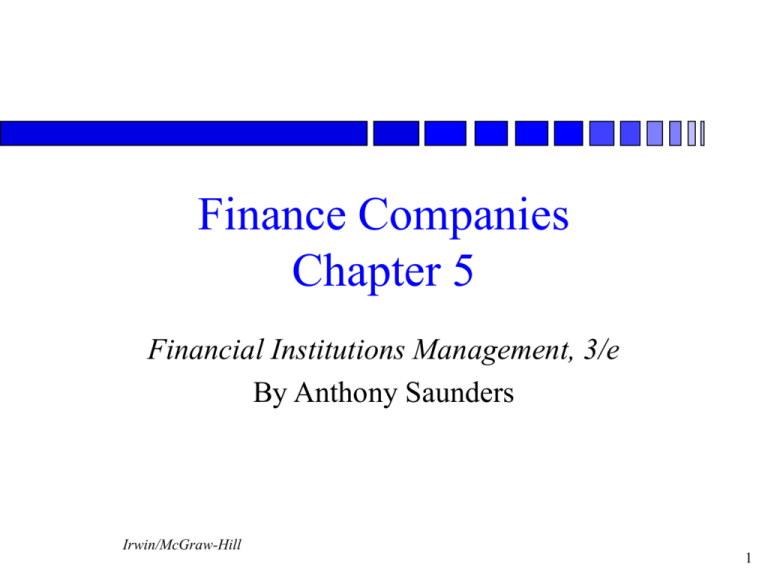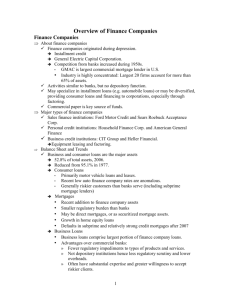Transparencies to accompany A. Saunders' FI Management
advertisement

Finance Companies Chapter 5 Financial Institutions Management, 3/e By Anthony Saunders Irwin/McGraw-Hill 1 Historical Perspective • Finance companies originated during the depression. » General Electric Capital Corporation. » Competition from banks increased during the 1950s. • Expansion of product lines » GMAC is the largest commercial mortgage lender in U.S. • Industry is highly concentrated » The largest 20 firms account for more than 80% of assets. Irwin/McGraw-Hill 2 Finance Companies • Their activities are similar to banks, but they have no depository function. • May specialize in installment loans (e.g. automobile loans) or may be diversified, providing consumer loans and financing to corporations, especially through factoring. • Commercial paper is a key source of funds. • Captive Finance Companies: e.g. GMAC Irwin/McGraw-Hill 3 Major Types of Finance Companies • Sales finance institutions » Ford Motor Credit and Sears Roebuck Acceptance Corp. • Personal credit institutions » Household Finance Corp. and American General Finance • Business credit institutions » CIT Group and Heller Financial » Equipment leasing and factoring Irwin/McGraw-Hill 4 Balance Sheet and Trends • Business and consumer loans are the major assets » 63.4% at 3rd quarter of 1997. » Reduced from 95.1% in 1977. • Increases in real estate loans and other assets. • Growth in leasing (largely due to tax incentives of 1981 Economic Recovery Act). Irwin/McGraw-Hill 5 Balance Sheet and Trends • Consumer loans » Primarily motor vehicle loans and leases. » Current low rates from auto finance companies are anomalous. » Generally riskier customers than banks serve. » Recent increase in “loan shark” firms with rates as high as 30% or more. » Other consumer loans about 27.5% of consumer loan portfolio, August 1997. Irwin/McGraw-Hill 6 Balance Sheet and Trends • Mortgages » Recent addition to finance company assets. » May be direct mortgages, or as securitized mortgage assets. » Growth in home equity loans since passage of Tax Reform Act of 1986. • Tax deductibility issue. Irwin/McGraw-Hill 7 Business Loans • Business loans comprise largest portion of finance company loans. • Advantages over commercial banks: » Fewer regulatory impediments to types of products and services. » Not depository institutions hence less regulatory scrutiny and lower overheads. » Often have substantial expertise and greater willingness to accept riskier clients. Irwin/McGraw-Hill 8 Liabilities and Recent Trends • Major liabilities: commercial paper and other debt (longer-term notes and bonds). • Finance firms are largest issuers of commercial paper (frequently through direct sale programs). • The most successful finance companies are becoming takeover targets. » Example: Money Store / First Union Bank Irwin/McGraw-Hill 9 Regulation of Finance Companies • Federal Reserve definition of Finance Company » Firm, other than depository institution, whose primary assets are loans to individuals and businesses. • Subject to state-imposed usury ceilings. • Much lower regulatory burden than depository institutions. » Not subject to Community Reinvestment Act. Irwin/McGraw-Hill 10 Regulation • With less regulatory scrutiny, finance companies must signal safety and soundness to capital markets in order to obtain funds. • Lower leverage than banks (11.0% capitalassets versus 8.80% for commercial banks). • Captive finance companies may employ default protection guarantees from a parent company or other protection such as letters of credit. Irwin/McGraw-Hill 11





